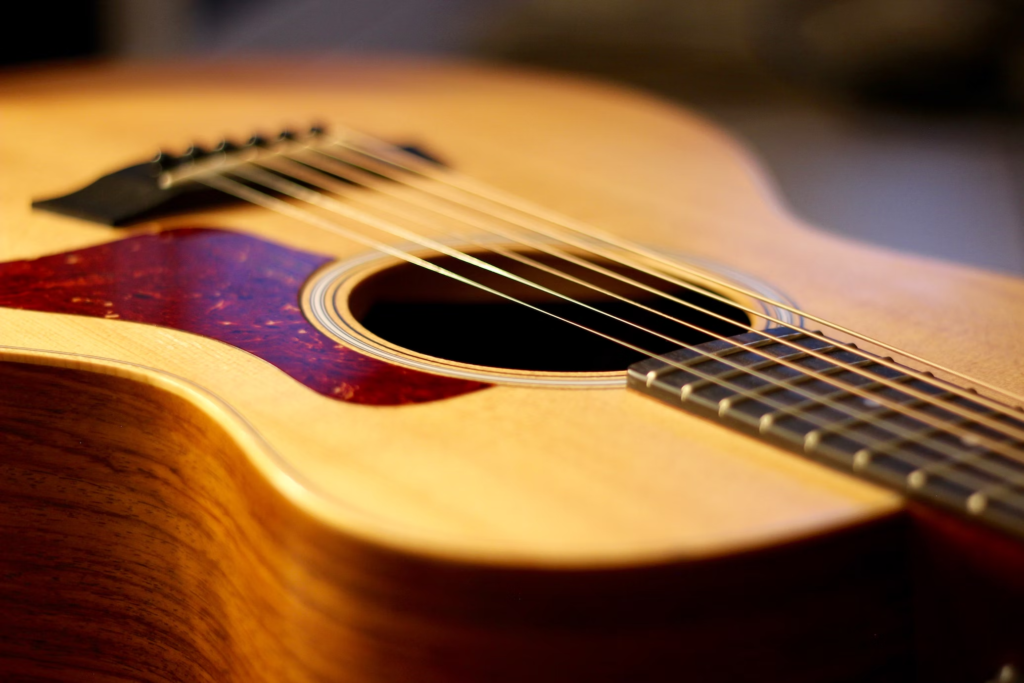
How to Use Chromatic Tuner: Calling all guitar enthusiasts! Achieving perfect pitch is crucial for beautiful music. In this post, explore the world of chromatic tuners—what they are, how they differ, and how to use one effectively for tuning your guitar. Grab your instrument, and let’s dive into the art of achieving pitch-perfect sound.
Table of Contents
What Is Standard Tuning On A Chromatic Tuner?
Before we delve into the specifics of a chromatic tuner, it’s important to understand the concept of standard tuning. Standard tuning refers to the most commonly used tuning for guitars, where the strings are tuned to E-A-D-G-B-E from low to high. A chromatic tuner is a tool for tuning your guitar to this standard tuning or any other desired tuning accurately.
If you are not familiar with the term “chromatic” this is the type of tuner that displays what note you are playing as you tune the guitar. For example, if you are trying to tune the “B” string you would turn the tuning gear until a “B” appeared in the display. A chromatic tuner allows you to tune your guitar to any pitch within the chromatic scale, which includes all the flats and sharps between the 12 notes in music.
Whether you want to tune to an alternate octave or prefer to tune to a different note altogether, a chromatic tuner allows you to do so with ease. The reason why people opt for chromatic tuners is that they offer more flexibility compared to regular tuners. Chromatic tuners are also used at work by detecting the exact pitch of a note, not just the nearest note. For instance, if you pluck a string and the tuner detects that the pitch is slightly off from the desired note, it will indicate that the string needs to be tuned up or down by a semitone (half step) or a whole step (two semitones).
What Is the Difference Between a Chromatic Tuner and a Regular Tuner?
You might be wondering how a chromatic tuner differs from a regular tuner. Well, the main difference lies in their functionality. While regular tuners are designed to detect specific notes or pitches, chromatic tuners can detect all the notes within the chromatic scale.
While regular tuners are designed to tune specific strings to a specific pitch, chromatic tuners give you the flexibility to tune to any note you want. This means you can use a chromatic tuner for alternate tunings or when you want to tune your guitar to a specific song’s key.
On the other hand, a chromatic tuner can be used to tune any note or interval, making it more versatile for different playing styles and alternative tunings. It gives you the flexibility to tune to any desired note, whether it’s an octave higher or lower, “D” or whatever note you want.
How Do Chromatic Tuners Work?
Chromatic tuners work by detecting the fundamental frequency of the sound produced by your guitar’s strings, detecting the pitch of the note you are playing, and displaying it on a meter or a digital display. When you pluck a string, the tuner analyzes the pitch and displays the corresponding note on a digital screen. This makes it easier for you to adjust the tension of your guitar strings and achieve the desired pitch.
When you pluck a string, the tuner analyzes the frequency of the sound and tells you whether the note is flat, sharp, or in tune. Some tuners even have a needle that moves to indicate how close you are to the desired pitch. Whether you want to tune one whole step up or down from the standard tuning, a chromatic tuner provides precise detection and accurate tuning.
How Does a Chromatic Tuner Pedal Work?

Image by Thomas Evans from Unplash
A chromatic tuner pedal is a popular choice among guitarists due to its ease of use and effectiveness. It works by connecting your guitar to the pedal using a cable. When you play a note, the pedal’s built-in microphone or input jack picks up the sound and displays the note on its screen. This allows you to tune your guitar accurately even while playing live on stage.
How to Use Chromatic Tuner?
To chromatic-tune your guitar, you’ll need a chromatic tuner. Using a chromatic tuner to tune your guitar is a straightforward process. To chromatic tune a guitar, you’ll want to start by plugging your guitar into the chromatic tuner pedal or connecting it to the tuner using a cable.
Here’s a step-by-step guide:
- Connect your guitar to the tuner pedal using a cable or use a clip-on tuner that attaches directly to the headstock of your guitar.
- Turn on the tuner and select the chromatic mode if necessary.
- Start by turning the tuning peg of the string you want to tune. For example, if you want to tune the low E string, turn the tuning peg until the string reaches the desired pitch.
- Put the tuner in front of you or clip it onto the headstock of your guitar.
- Play each string individually, starting from the thickest (low E) to the thinnest (high E). The tuner will display the closest note to the pitch you are playing.
- Adjust the tension of each string until the tuner indicates that it’s in tune.
- Repeat the process for all strings until your guitar is perfectly tuned.
To understand this better, let’s consider an example. Imagine you want to tune your guitar to the note “D.” Using a chromatic tuner, you would pluck a string and the tuner would detect the frequency of the sound produced. It will then identify the closest note to that frequency, which in this case would be “D.” The tuner will display the note “D” on its screen, indicating that you need to adjust the string to make it sound like a “D.”
How Accurate is the Chromatic Tuner?

Image by Matija Sundalic from Unplash
Chromatic tuners are known for their accuracy in detecting the pitch of your guitar strings. They are designed to be precise, allowing you to achieve pitch-perfect intonation. However, it’s always a good idea to trust your ears as well and make slight adjustments based on how the notes sound to you.
Chromatic tuners are generally very accurate, with most models boasting a precision of +/- 1 cent, which is a very small interval in musical terms. A cent is a unit of measurement used to describe the difference in pitch between two notes. To put it into perspective, there are 100 cents in between each semitone or half step. So, you can rely on your chromatic tuner to get your guitar accurately tuned.
However, it’s good to know that some higher-end tuners offer even greater accuracy, allowing for precise tuning adjustments. Most chromatic tuners have a built-in calibration feature, allowing you to adjust the reference pitch to 440Hz or any other desired frequency. They can typically detect pitch variations as small as one whole step or one semitone.
Tips
- When using a chromatic tuner, it’s best to tune your guitar in a quiet environment to minimize external noise interference.
- Always start with the thickest string (low E) and work your way to the thinnest string (high E) for a systematic tuning process.
- If you’re a beginner, consider using a guitar tuner app on your smartphone, such as Snark or an iPhone’s built-in tuner. These apps provide visual cues to help you tune your guitar accurately.
- If you’re tuning an acoustic guitar, make sure the room is relatively quiet to ensure accurate readings.
- If you’re having trouble tuning your guitar, try playing the harmonic instead of the fretted note for a clearer tone.
- Consider using a tuner app on your smartphone, such as “Tuner Lite” for iPhone users. It’s a portable and convenient option. These apps are portable and convenient for tuning on the go.
- It’s always a good idea to learn how to tune your guitar by ear as well. This skill can come in handy when you don’t have a tuner available.
- If you’re using an app as a chromatic tuner, make sure to use it in a quiet environment to avoid interference from background noise.
- If you’re unsure of the standard tuning, you can use the chromatic tuner to play the note of each string and match it to the corresponding pitch.
- If you want to play your guitar in a different tuning, simply adjust the chromatic tuner to the desired note or chord. The tuner will guide you in achieving the correct tension for each string.
- Experiment with different ways to tune your guitar, such as matching harmonics or using reference pitches from other instruments.
- If your tuner has a built-in microphone, you can even use it to tune other instruments besides the guitar. Another example where a chromatic tuner comes in handy is when you want to tune a specific instrument that doesn’t follow the standard tuning, such as a violin or a ukulele.
Warnings
- Be careful not to overtighten the strings while tuning, as it can lead to breakage or damage to your instrument.
- Avoid relying solely on electronic tuners. Developing a good sense of pitch by ear is essential for any musician.
- Be careful when turning the tuning pegs, especially if you have a tremolo bridge or whammy bar system. Sudden changes in tension can affect the bridge’s balance and cause tuning stability issues.
Conclusion
A chromatic tuner is a valuable tool for any guitarist, whether you’re a beginner or an experienced player. It provides a reliable reference point for tuning your guitar accurately, ensuring that each string is at the correct pitch. By using a chromatic tuner, you’ll enhance the overall sound and playability of your instrument.
Whether you’re a beginner or a seasoned player, having a reliable tuner can make a big difference in your playing experience. So grab your chromatic tuner, start tuning, and let the rhythmic sounds of your well-tuned guitar fill the air. Don’t fret about tuning your guitar by ear, get yourself a chromatic tuner pedal and let the music flow. It works by detecting the frequency of the sound waves produced by the vibrating strings of a guitar and helps you achieve perfect tuning.
Grab a chromatic tuner, tune your guitar, and embark on a musical journey with confidence and precision. Whether you’re playing in standard tuning or exploring alternate tunings, a chromatic tuner will be your trusted companion in achieving the perfect pitch you desire. Happy tuning.
(Note: This blog post is intended for informational purposes only. Always refer to the manufacturer’s instructions for your specific chromatic tuner model. If you want to learn more about tuning your guitar or other instruments, check out in YouTube channel for tutorials and helpful tips.)






